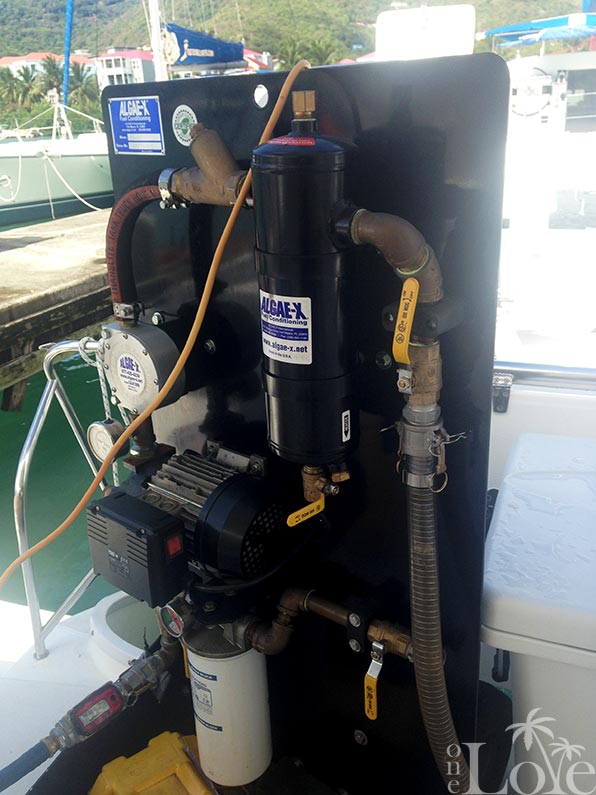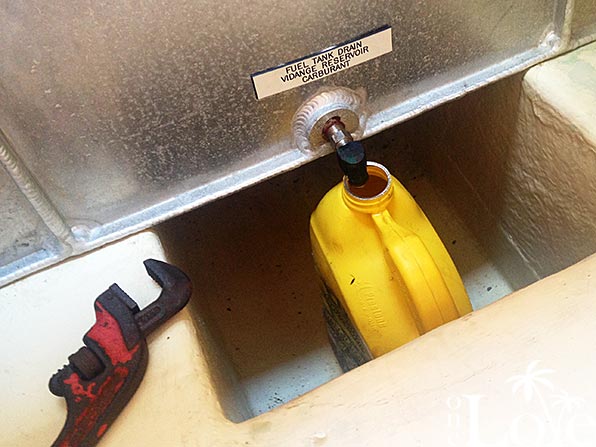Preventative Maintenance Day
There is something to be said for someone who understands the value of preventative maintenance. We are fortunate the owner of the boat we are working on is such a person. We spent the day on the dock yesterday where our friendly marine service guy Rayon, and his buddy Mark, ticked off a few tasks for us that we hope will lesson the chance of drama during our busy charter schedule.
Top on the to-do list was cleaning the fuel tanks. This involved first pumping out all of the diesel through a polishing system and storing it temporarily in numerous jerry jugs that they had brought for the job. I should point out that we have completed two charters since refueling, deliberately letting the fuel supply get as low as we dared. When the diesel had been removed, Rayon and Mark set about cleaning the tanks, removing a good amount of sludge in the process. When they were happy that they had done as good a job as possible, they returned a portion of the polished diesel, fuel that they were confident was clean.




Next up on the to-do list was removing and cleaning the two holding tanks. Over time, the walls and pipes of the aluminum tanks become caked with calcium and other solid matter (use your imagination). In order to deal with this, the guys had to first disconnect all of the hoses and then take the tanks out onto the dock. After rinsing them off with a hose, the tanks were soaked with On and Off and left to rest. At some point later in the day, following a good amount of scraping, beating and shaking to remove the crud, the tanks were clean enough to reinstall.



Thanks again to Rayon and Mark. Not only did they complete everything that they said they would do yesterday, they also fixed a broken wire on our alternator which had been giving us a false error light at our helm. These are definitely good contacts for boaters like us to have. For those in need, Rayon can be reached at 284-340-5312.


They did what they said, and when they said they would !? That is better than the states…
better than most!
Excellent!
Sounds like something you would do.
Are you really sure you had this done in the islands??? 🙂
Hard to believe, isn’t it?
Algae-X = scam. and they’re not even embarrassed about it. It has never done ANYTHING in dependent testing. Your system is not sterile… unless they also added an effective biocide. So you need to start with a consistent, preventative biocide program. Bio-bor, Raycor, and several others. Something containing either boranes or carbamates. Just follow the instructions.
Aluminum holding tanks? With seawater and urine, that is the single worst material available. Much of the crud you removed was probably aluminum corrosion products. As you know from your PDQ, removing tanks for cleaning should be unneccesary, since plastic is slick and resitis the build-up, while aluminum draws it. Honestly, I’m cheap and I would not have re-installed them unless I could do some thickness testing. If they leak in time, do not repair, do not consider stainless, go straight to polyethylene. Google the sad stories.
But great service.
Scam in what way?
I plan to add the biocide as you and I discussed.
As for the holding tanks, interestingly I saw a whole pile of “plastic” tanks sitting on the dock. I was told they are replacing the ones in the 4600s (the guys thought) with the new ones. They did say that it involved a bit of customization though. I was not simply a drop in replacement.
There are magnets in the round aluminum model. Kind of like magnets for arthritis. The actual filters work fine.
There are, of course, cheap plastic tanks, as well as tanks that are poorly mounted and move. When replacement times comes, just be sure to ask around a little. Ronco is good. Personally, I think I would go for carefully engineered FRP, based on my PDQ experience. But you’ve got to use the correct resin and methods, so plastic is certainly cheaper.
Magnets, eh?
I put plastic in quotes because I wasn’t really sure what the tanks I saw were made of.
We’ve had our fuel polished before, most recently as our boat sat in the Amelia Island Yacht Basin at Fernandina Beach, Florida. In all cases, the vendors recommended that the tanks be at least 75% full, not pumped out. The fuel is drawn from the tanks, filtered, and then returned to the tanks under a fair amount of pressure. The fuel is then continuously filtered and returned to the tank in a loop. The return pressure is used to stir up the inside of the tank and loosen any gunk. It’s not a quick procedure. For our three tanks (180 US gallons) the whole procedure took several hours…about four, to be a bit more precise. The procedure you describe above would seem to do very little to clean out the gunk in the tank that is the real culprit.
I suspect there is more than one way to skin a cat.